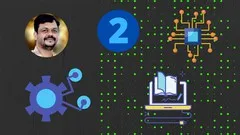
Ultimate 2022 Digital Circuits and Logic Design course 
Discover the Ultimate 2022 Digital Circuits and Logic Design course offered by Power Tech Academy. This comprehensive course is designed to provide students with a deep understanding of digital logic circuits and how they function within a computer. From learning base number systems to optimizing circuit diagrams, students will gain valuable knowledge and skills. The course also includes hands-on assignments and exercises, as well as software simulations using Logisim and Multisim. With dedicated sections covering topics such as logic gates, gate level minimization, and sequential logic circuits, this course is perfect for anyone interested in digital electronics and logic design. Don't miss out on this opportunity to enhance your understanding of digital circuits and logic design. Enroll now! ▼
ADVERTISEMENT
Course Feature
![]() Cost:
Cost:
Paid
![]() Provider:
Provider:
Udemy
![]() Certificate:
Certificate:
Paid Certification
![]() Language:
Language:
English
![]() Start Date:
Start Date:
2022-07-04
Course Overview
❗The content presented here is sourced directly from Udemy platform. For comprehensive course details, including enrollment information, simply click on the 'Go to class' link on our website.
Updated in [September 27th, 2023]
What does this course tell?
(Please note that the following overview content is from the original platform) Power Tech Academy introduces a special course for ( Digital Circuits and Logic Design )This course is designed to teach students how to design a digital logic circuit to perform a specific desired function Taking this course will give students a much better understanding of how the internals of a computer work so our course aims to teach students the fundamentals of digital logic design Starting from learning the basic concepts of the different base number systems ( Binary - Decimal - Hexadecimal ) and their Conversions to basic logic elements and deriving logical expressions to further optimize a circuit diagram Also we use software for simulation and implementation of our Logic circuits which already we made Designs for them like " Logisim & Multisim "This course is structured in such a way that each section is dedicated to a specific topic in regards to digital electronics and Logic Design The lectures contained in each section describe in detail the different tools and techniques used to design digital logic circuitsThere are assignments and Exercises throughout this course that students can use to put the theory taught to practical use There are also two sections for using software of simulation " Logisim & Multisim " so you can get the most benefit from this course Plan of Our Course will be like that :1- section (1) : ( Introduction ) - introduction for Digital system and Logic Design - Numbering systems and their conversions - Arithmetic operations for Binary System2- section (2) : ( Basic and Specialized Logic Gates and their applications ) - Basic Logic gates ( AND OR NOT ) their Symbols and Truth tables - Universal Logic gates ( NAND NOR ) their Symbols and Truth tables - Specialized Logic gates ( X-OR & X-NOR) their Symbols and Truth tables - Simplification of Logic equations using Algebraic manipulation3- section (3) : ( Gate Level Minimization ) - Concept of Minterms and Maxterms - Concept of SOP and POS for standard implementation - all Types of K-maps ( 2 variables 3 variables 4 variables 5 variables ) - Dont care Conditions and how can you get the POS using K-map4- section (4) : ( Combinational Logic Circuits ) - Design of half Adder - Design of Full Adder - 8-bits Binary Adder - Binary Subtractor - Binary ( Adder - Subtractor ) - BCD Adder - Binary Multiplier - Binary Magnitude Comparator - Design of ( Decoder & Encoder ) - Design of ( Multiplexer & Demultiplexer )5- section (5) : ( Logisim Software ) 6- section (6) : ( Logic waves and Devices of measuring for Digital systems ) - Logic Waves parameters ( period Frequency Duty Cycle ) - Basic Digital Devices ( LEDs 7-Segments Dot Matrix Ressistors ICs ) - Measuring Devices of Digital Systems ( oscilloscope Logic Analyzer Function generator ) 7- section (7) : ( Multisim Software )8- section (8) : ( Laboratory for implementation some Logic Circuits practically using Breadboard )9- section (9) : ( Sequential Logic Circuits ) - Types of Sequential Logic Circuits - ( SR & D ) Latches - ( D JK and T ) Flip Flops - [ Finite State Machine (FSM)
We considered the value of this course from many aspects, and finally summarized it for you from two aspects: skills and knowledge, and the people who benefit from it:
(Please note that our content is optimized through artificial intelligence tools and carefully reviewed by our editorial staff.)
What skills and knowledge will you acquire during this course?
By taking the Ultimate 2022 Digital Circuits and Logic Design course, students will acquire the following skills and knowledge:
1. Understanding of digital systems and logic design: Students will gain a comprehensive understanding of digital systems and how logic circuits are designed to perform specific functions.
2. Knowledge of numbering systems and conversions: Students will learn the basic concepts of binary, decimal, and hexadecimal numbering systems, as well as how to convert between them.
3. Familiarity with basic and specialized logic gates: Students will learn about basic logic gates such as AND, OR, and NOT, as well as specialized logic gates like NAND, NOR, X-OR, and X-NOR. They will understand their symbols, truth tables, and applications.
4. Simplification of logic equations: Students will learn how to simplify logic equations using algebraic manipulation techniques, making circuit designs more efficient.
5. Gate level minimization: Students will understand the concepts of minterms, maxterms, SOP (Sum of Products), and POS (Product of Sums) for standard implementation. They will also learn how to use K-maps for simplification and handle don't care conditions.
6. Design of combinational logic circuits: Students will learn how to design various combinational logic circuits, including half adders, full adders, binary adders and subtractors, BCD adders, binary multipliers, decoders, encoders, multiplexers, and demultiplexers.
7. Practical implementation using Logisim software: Students will gain hands-on experience using Logisim software for simulation and implementation of logic circuits.
8. Understanding of logic waves and measuring devices: Students will learn about logic wave parameters such as period, frequency, and duty cycle. They will also become familiar with basic digital devices like LEDs, 7-segment displays, dot matrix displays, resistors, and ICs. Additionally, they will learn how to use measuring devices such as oscilloscopes, logic analyzers, and function generators for digital systems.
9. Practical implementation using Multisim software: Students will gain practical experience using Multisim software for simulation and implementation of logic circuits.
10. Laboratory experience with breadboard implementation: Students will have the opportunity to implement logic circuits practically using a breadboard in a laboratory setting.
11. Understanding of sequential logic circuits: Students will learn about different types of sequential logic circuits, including SR and D latches, D, JK, and T flip-flops, and finite state machines (FSM).
Who will benefit from this course?
This course on Digital Circuits and Logic Design will benefit a variety of individuals, including:
1. Students studying computer science or electrical engineering: This course provides a comprehensive understanding of digital logic design, which is a fundamental concept in these fields. It covers topics such as numbering systems, logic gates, minimization techniques, combinational logic circuits, sequential logic circuits, and more. Students will gain the necessary knowledge and skills to design and analyze digital circuits, which will be valuable in their academic and professional pursuits.
2. Professionals working in the field of digital electronics: This course serves as a refresher or a way to enhance the knowledge of professionals already working in the field. It covers both basic and specialized logic gates, gate level minimization techniques, and various types of logic circuits. Professionals can benefit from this course by gaining a deeper understanding of digital circuits and logic design, which can help them in their day-to-day work or when troubleshooting complex systems.
3. Hobbyists and DIY enthusiasts: Individuals interested in electronics and digital systems can also benefit from this course. It provides a step-by-step guide to designing and implementing digital circuits using software simulation tools like Logisim and Multisim. Additionally, the course includes a section on practical implementation using a breadboard, allowing hobbyists to apply their knowledge and build their own digital circuits.
Course Syllabus
Introduction for Digital Circuits and Logic Design
Basic and Specialized Logic gates
Gate Level Minimization
Combinational Logic Circuits
Logisim software
Logic Waves and devices of Measurement for Digital Systems
Multisim Software
Lab for implementation some Logic Circuits
Course Provider

Provider Udemy's Stats at AZClass
Discussion and Reviews
0.0 (Based on 0 reviews)
Explore Similar Online Courses

Historical Airphoto Processing (HAP) with PCI Geomatics

SAP Crystal Reports:Master-DetailCross-TabSub-Reports

Python for Informatics: Exploring Information

Social Network Analysis

Introduction to Systematic Review and Meta-Analysis

The Analytics Edge

DCO042 - Python For Informatics

Causal Diagrams: Draw Your Assumptions Before Your Conclusions

Whole genome sequencing of bacterial genomes - tools and applications

The Ultimate : Digital System Design ( Module - 1)

CMOS Digital Integrated Circuit Design


Start your review of Ultimate 2022 Digital Circuits and Logic Design course